As a result of an unconventionally warm winter, the Great Lakes’ ice cover is almost non-existent and has reached a historic record low.
Keep reading this article to get all the facts and data and discover just how little ice there currently is on the five Great Lakes and Lake St. Clair.
A Tough Year for Ice Fishing on the Great Lakes
If you’re an ice angler like me, chances are you’ve had a hard time finding good ice this year. It seems like we just can’t get rid of this winter’s abnormally high temperatures.
I mean, I think many of us are used to milder periods during the winter by now, but this is unheard of if you ask me!
There was hope about a month ago when cold weather finally hit the Northeast, Midwest, and Southern Canada, but, as we all noticed, that didn’t last very long.
By the beginning of February, the warmth had returned and wreaked havoc with the ice on the Great Lakes.
Then, on February 8, 2024, the lakes’ ice coverage hit a new all-time record low. And since then, things have gone south even more.
And yes, “all-time” means since 1973, which is when this type of data was first being collected.
Still, a 25% decrease in basin-wide ice cover over a relatively short period of just 50 years is huge!
Additionally, records have shown that the average length of the Great Lakes ice season has declined by 27 days since 1973. Again, a significant change. And the 2024 season isn’t even included in this data!
But how bad is this year really?
Well, I’ve checked a lot of NOAA research data over the last couple of days and read through many reports in various Great Lakes Facebook groups.
Conclusion: things look pretty dismal!
I mean, three of the Great Lakes practically have no ice at all, and even the region’s ice fishing stronghold, Chaumont Bay (Lake Ontario), which always tends to freeze during warmer winters, is wide open.
That tells us quite a bit, doesn’t it? But let’s take a look at the data from the NOAA Great Lakes Environmental Research Laboratory.
I thought it best to list every lake separately so that you can get a better and more organized picture of the situation. Here we go!
Current Great Lakes Ice Coverage and Surface Temperatures
Lake Erie
Average Ice Cover
So, Erie currently has no ice at all. Things looked good there for a while in mid-January; the lake hit its maximum ice coverage (35.72%) on Jan 22.
After that, though, the warmth made a comeback, and a few days ago, on Feb 13, there was 0 ice left on Lake Erie.
Surface Temperatures
As you can see, the northeastern part of the lake is way too warm, but the southwestern part of Lake Erie has surface temperatures around 32F.
That means that a cold spell could bring back the ice to that part of the lake fairly quickly. But for that to happen, it would have to get cold.
And according to the weather forecast for Sandusky (OH), which is near Catawba Island (a popular ice fishing area), that’s just not going to happen:

Local weather forecast for Sandusky, Ohio. (Source: weather.com)
Lake Huron
Average Ice Cover
So, Huron sort of is the “anomaly” of the 5 Great Lakes, as it currently has an ice cover of 8.16%.
Still, its average for mid-February is around 50% ice coverage, so it’s anything but normal.
Surface Temperatures
Additionally, all of the ice is on the Northern Channel, the eastern shoreline of Georgian Bay, and parts of Saginaw Bay. The main lake is wide open!
This is very interesting (yet concerning); the main basin of Lake Huron, as well as the western parts of Georgian Bay show surface temperatures of 40 to 45F. That is absolute madness for this time of year!
Again, large parts of the lake’s bay areas have much lower surface temperatures and could build good ice fairly quickly if it wasn’t for the high temperatures that appear to persist until the end of February.
This one is for Bay City (Michigan), near Saginaw Bay:
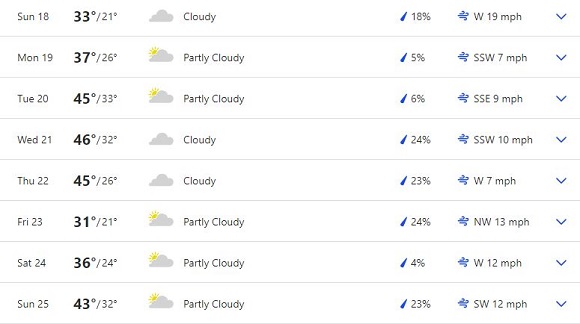
Local weather forecast for Bay City, Michigan. (Source: weather.com)
Lake Michigan
Average Ice Cover
Lake Michigan currently only has 2.98% ice coverage, which is extremely low.
Even during the cold spell of January, the lake never got more than 18% of ice and could soon be completely open.
Only parts of Little and Big Bay De Noc and the most northern part of Lake Michigan currently have some ice on them.
Surface Temperatures
Much like Huron, the surface temperatures of Lake Michigan are way too high for this time of year.
While the main basin shows temperatures of 40 to 45F, there are some areas that edge close to 48F!
Only the most northern part of the lake and Green Bay have surface temperatures of around 32F and could freeze over relatively fast.
Once again, however, the weather forecast tells us otherwise.
This one’s for Green Bay in Wisconsin:
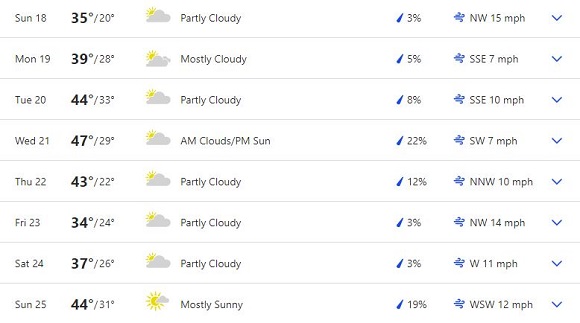
Local weather forecast for Green Bay, Wisconsin. (Source: weather.com)
Lake Ontario
Average Ice Cover
Alright, so Lake Ontario always has the lowest ice cover of the five Great Lakes! However, it still has an annual average of 20%, and the coverage should be at its maximum right now.
Instead, the lake has a mere 0.91% ice at the moment. And even during the cold weather back in January, the lake just got a little over 5% ice coverage.
What’s really unusual is the fact that Lake Ontario’s well-protected bays, Chaumont, Handerson, and Black River, are open as well!
Even during warm winters of the past, at least Charmont Bay always froze over. It used to be the Great lakes stronghold for ice anglers. But no more!
Here is a recent drone image of Chaumont Bay from Feb 16. As you can see, there’s almost no ice left.
At least parts of the Bay of Quinte area still appear to have some decent ice!
Surface Temperatures
As you can see, Lake Ontario’s main basin is extremely warm, with surface temperatures of 40 to 48F!
The northwestern part of the lake looks a little better but is still far too warm for this time of year, with surface temperatures of 35 to 38F.
Only Bay of Quinte temperatures of around 32F.
Night temperatures for the Chaumont area look promising over the next few days, but day temps are fairly high, so I don’t think there will be much ice built.
Furthermore, the forecast shows that daytime temperatures could reach up to 50F the week after next, so this could be it for the 2024 ice fishing season!
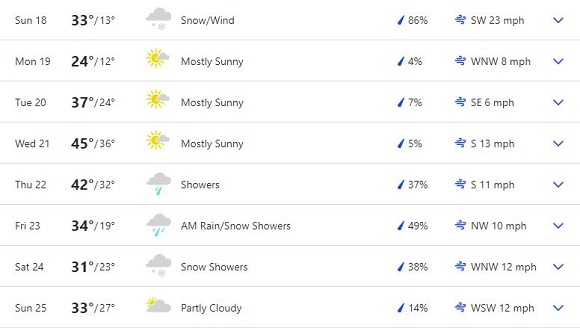
Local weather forecast for Chaumont, New York. (Source: weather.com)
Lake Superior
Average Ice Cover
Last but not least, we’ve got the most northern of the five Great Lakes: Lake Superior.
This is perhaps the most radical example of all! Normally, Superior should have around 40 to 50% of ice this time of year.
Instead, the current ice coverage is a staggering 2.16%, which basically means that almost the entire Lake Superior is open.
Again, we’re talking about Lake Superior in the middle of February here!
Only the northern bays on the Canadian side of the lake, Thunder, Black, and Nipigon, are currently covered with ice.
Surface Temperatures
As you can see, the main basin, as well as the western end of the lake, have very high surface temperatures that range from 35 to 45F!
Only the central and northern parts of Lake Superior show lower temperatures of 32 to 37F.
I’ve checked the weather forecast for Duluth (Minnesota), which is located close the most western end of Lake Superior.
During normal winters, there’s a lot of ice fishing activity going on around Duluth. But with the persisting warm daytime temperatures, it’s highly unlikely that there will be much, or any ice at all, in the coming days and weeks.
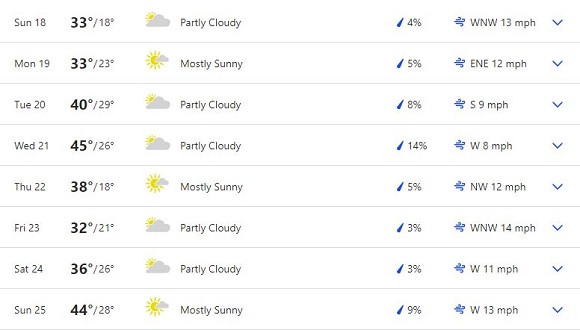
Local weather forecast for Duluth, Minnesota. (Source: weather.com)
Is This the End of Ice Fishing on the Great Lakes, Then?
I really don’t know, and I certainly don’t hope so!
I know many out there don’t want to hear that or laugh at the idea (which is totally fine, of course), but the climate is definitely changing, and our winters and, hence, our ice fishing season are getting shorter and shorter!
I mean, there have always been warmer winters, El Nino winters, shorter warm periods in the middle of dead winter, and so on.
I don’t dispute that at all! What we are witnessing now, though, and have for several years, is unprecedented if you ask me!
The climate, weather, and environment are always changing, no doubt about that!
What I am concerned about is the speed at which the climate appears to change!
Just 20, 25 years ago, there were still long and hard winters that you could basically count on every year!
Just look at the Great Lakes Ice Coverage in 2003 vs. 2023! That’s 20 years!
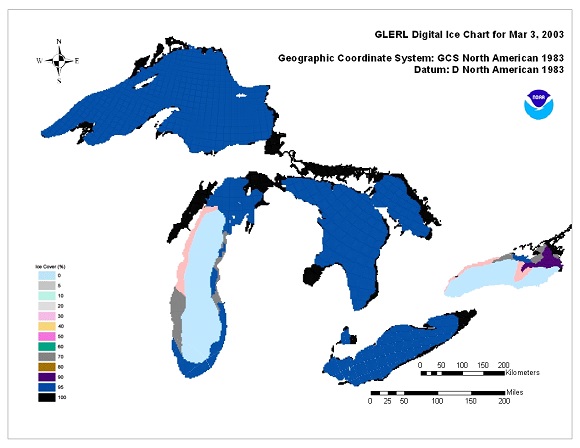
Digital Ice Chart, March 3, 2003 (Courtesy of NOAA GLERL)
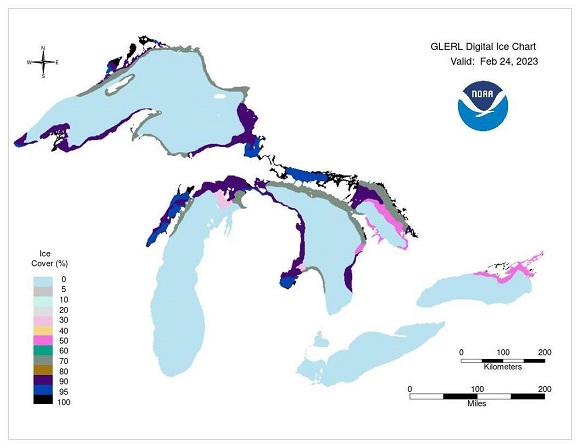
Digital Ice Chart February 24, 2023 (Courtesy of NOAA GLERL)
And yes, there are variations, of course! Some winters between 2003 and 2023 were very cold, and some winters before 2003 were unseasonably warm. Again, I am not arguing against that at all.
But there is a downward trend going on, and, personally, I think it’s getting harder and harder to deny that.
Lastly, there is the graph for the Great Lakes ice cover so far during 2024:
On February 16, 2024, the combined ice cover for all five Great Lakes was 3.45%.
The annual average is around 40% for mid-February.
3.45% vs. 40%! That is more than 10 times lower than the annual average.
I am not saying (or, rather, hoping) that this will be the new normal, but I do believe that many of us will have to get used to shorter and warmer winters, less ice, and, hence, shorter ice fishing seasons!
I really hope, though, that we’ll still have an ice fishing season 10 or 20 years from now! It would be a shame to lose this wonderful aspect of the sport.
Tight lines, and stay safe out there!
Featured image courtesy of NOAA GLERL
The post The Lost Winter: Great Lakes Ice Coverage Hits All-Time Record Low appeared first on Strike and Catch.
https://strikeandcatch.com/the-lost-winter-great-lakes-ice-coverage-hits-all-time-record-low/
 CampingSurvivalistHuntingFishingExploringHikingPrivacy PolicyTerms And Conditions
CampingSurvivalistHuntingFishingExploringHikingPrivacy PolicyTerms And Conditions
